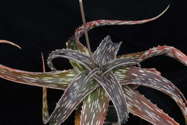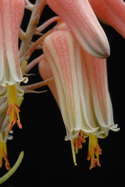Just described in 2014 (Cactus World 32(3): 201), this member of the A. somaliensis complex shares its glossy, attractively marked leaves which in this case blush a chocolate-brown with elongate silver-white dashes accentuating their slenderness. The leaves recurve in grappling-hook fashion, resulting in rosettes that reach well beyond the confines of a pot. It stands out among its allies in its eventually dense rosettes of up to 40 leaves and inflorescences to nearly 2 m (6') tall, though our potted specimens top out at about 65 cm (2'). The original collection of seed in November, 2002, was distributed to a few aloe enthusiasts who seemed to be in a race to propagate this desirable species. Anthon Ellert wins the prize for producing sufficient quantity for an ISI introduction. Apparently his Arizona heat made the plants feel at home—the pumice-strewn Mabra plain in the shadow of Mt. Nabro is equally sweltering. However, the plant has also grown and flowered well in the Huntington’s greenhouse where it has produced much seed. Its ease of culture, free-flowering nature, and attractive foliage and flowers make this a new species destined to persist in collections. Its status in the wild is uncertain as no botanists have visited the habitat since the eruption of Mt. Nabro in June, 2011. HBG 123339, second generation plants from controlled pollination of a few plants from the original seed collection, Orlando & El Azzouni 222603, Nov, 2002, at 725 m elevation on the pumice plain below the eastern foothills of the Nabro volcano, Southern Red Sea Region, Eritrea. $15.

Published in the Cactus and Succulent Journal, Vol. 87 (3), May - June, 2015



